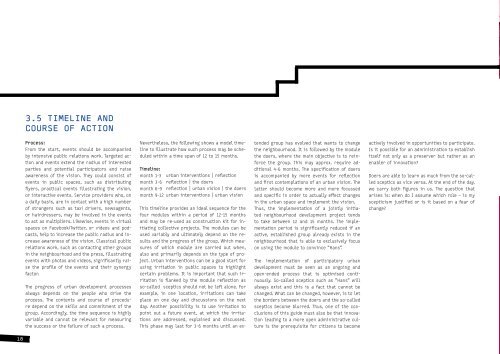CATALYSE_Shaking_Hans
CATALYSE_Shaking_Hans
CATALYSE_Shaking_Hans
Create successful ePaper yourself
Turn your PDF publications into a flip-book with our unique Google optimized e-Paper software.
3.5 TIMELINE ANDCOURSE OF ACTIONCREATIVE.QUARTERCITY NORD.ESSENProcess:From the start, events should be accompaniedby intensive public relations work. Targeted actionand events extend the radius of interestedparties and potential participators and raiseawareness of the vision. They could consist ofevents in public spaces, such as distributingflyers, practical events illustrating the vision,or interactive events. Service providers who, ona daily basis, are in contact with a high numberof strangers such as taxi drivers, newsagents,or hairdressers, may be involved in the eventsto act as multipliers. Likewise, events in virtualspaces on Facebook/Twitter, or videos and podcasts,help to increase the public radius and increaseawareness of the vision. Classical publicrelations work, such as contacting other groupsin the neighbourhood and the press, illustratingevents with photos and videos, significantly raisethe profile of the events and their synergyfactor.The progress of urban development processesalways depends on the people who drive theprocess. The contents and course of proceduredepend on the skills and commitment of thegroup. Accordingly, the time sequence is highlyvariable and cannot be relevant for measuringthe success or the failure of such a process.Nevertheless, the following shows a model timelineto illustrate how such process may be scheduledwithin a time span of 12 to 15 months.Timeline:month 1-3 urban interventions | reflectionmonth 3-6 reflection | the doersmonth 6-9 reflection | urban vision | the doersmonth 9-12 urban interventions | urban visionThis timeline provides an ideal sequence for thefour modules within a period of 12-15 monthsand may be re-used as construction kit for initiatingcollective projects. The modules can beused variably and ultimately depend on the resultsand the progress of the group. Which measuresof which module are carried out when,also and primarily depends on the type of project.Urban interventions can be a good start forusing irritation in public spaces to highlightcertain problems. It is important that such irritationis flanked by the module reflection asso-called sceptics should not be left alone. Forexample, in one location, irritations can takeplace on one day and discussions on the nextday. Another possibility is to use irritation topoint out a future event, at which the irritationsare addressed, explained and discussed.This phase may last for 3-6 months until an ex-tended group has evolved that wants to changethe neighbourhood. It is followed by the modulethe doers, where the main objective is to reinforcethe group. This may approx. require additional4-6 months. The specification of doersis accompanied by more events for reflectionand first contemplations of an urban vision. Thelatter should become more and more focussedand specific in order to actually effect changesin the urban space and implement the vision.Thus, the implementation of a jointly initiatedneighbourhood development project tendsto take between 12 and 15 months. The implementationperiod is significantly reduced if anactive, established group already exists in theneighbourhood that is able to exclusively focuson using the module to convince “<strong>Hans</strong>“.The implementation of participatory urbandevelopment must be seen as an ongoing andopen-ended process that is optimised continuously.So-called sceptics such as “<strong>Hans</strong>“ willalways exist and this is a fact that cannot bechanged. What can be changed, however, is to letthe borders between the doers and the so-calledsceptics become blurred. Thus, one of the conclusionsof this guide must also be that innovationleading to a more open administrative cultureis the prerequisite for citizens to becomeactively involved in opportunities to participate.Is it possible for an administration to establishitself not only as a preserver but rather as anenabler of innovation?Doers are able to learn as much from the so-calledsceptics as vice versa. At the end of the day,we carry both figures in us. The question thatarises is: when do I assume which role – is myscepticism justified or is it based on a fear ofchange?THE VENUEThe venue for the Research and Action Workshop(RAW): Atelierhaus Schützenbahn 19/21 inthe Creative.Quarter City Nord.EssenEssen, with its approx. 570,000 residents, is thefourth largest city in the Land of North Rhine-Westphaliaand is located in the middle ofthe Ruhr Region. The urban setting is dividedinto two parts: the densely inhabited city centretogether with the northern districts and thesouthern areas with their many green spaces.Zeche Zollverein – an industrial monument andUNESCO world heritage site – is the city’s landmark.The call for “work spaces for the arts“ in 2010was the occasion for the initiative “Freiraum2010“ to occupy the former DGB (German TradeUnions) building at the Schützenbahn in thenorthern districts of Essen‘s city. Two years later,in 2012, the first studio house, the venueof the RAW – also situated at the Schützenbahn– opened its doors and gave an impulse to openthe neighbourhood with its typical character toartists and creative professionals.The popularity of the former TV studio’s spaceswas as extraordinary as significant: the city’sdecision was to open the spaces in the formerlysparkling and now bleak City Nord.Essen forcreative professionals, now it is a visible triggerfor the development of the Creative.Quarter,which through art and culture has created anew feeling of community and brought togethervarious actors and residents who collectivelywant to develop the neighbourhood in a positivedirection. Therefore, the studio house not onlyacts as a place of work and creation for artistsbut also assumes the role of a local hub for allprotagonists of the neighbourhood and for theneighbourhood itself.Individuality instead of mainstream – visitingCity Nord.Essen you will encounter an increasingamount of idiosyncratic shops and smallproducers’ galleries next to food stalls of variousnationalities and original, trendy venueswith catering facilities. If you are out forspectacular industrial culture, you will searchin vain. The area’s special charm is a seeminglyinsignificant small-scale patchwork characterof a neighbourhood district. Behind it standsa neighbourhood’s feeling of community, a movementsimilarly connecting residents, tradesmen,entrepreneurs, artists, and city officers.Their common interest: urban spaces for a morelife-worthy future. Supporting and qualifyingartists and providing affordable studios andwork spaces are therefore equally on the agendaas are further measures to develop the Creative.Quarterand to promote the neighbourhood’sidentity.1819


